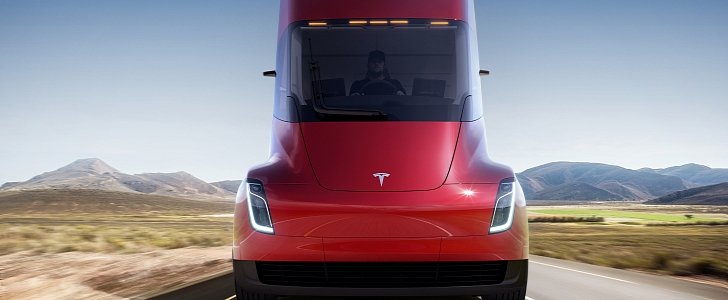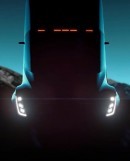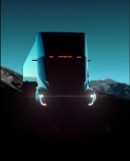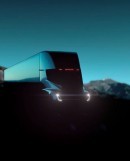The Tesla Semi event was pushed back twice, but now that it's happened, everything is forgiven. It's not so much that the presentation itself was anything to write home about (though it has to be said it was Musk's best to date), but the products? Not only would you write about them, but the paper would also have drooling marks.
Alright, so coming up with exciting vehicles was never a problem for Tesla. The Model X is arguably its least appealing effort so far, and it would have been even duller if it weren't for those Falcon Wings. Even so, it's the world's first electric SUV and one that can outperform sports cars on the quarter-mile.
The Semi, however, is in a different ballpark. Let's start with the design. Even though the teaser images were revealing enough and the spy shot from last month turned out to be accurate, meaning we kind of knew what it would look like, we still weren't ready to see it in the flesh
Compared to other trucks, it's at least 20 years ahead. It also manages to capture the Tesla brand image perfectly, which is mostly due to the company striving to make its vehicles as aerodynamic as possible. The Semi has a drag coefficient of 0.36 Cd, which is nothing short of astonishing. To put that into perspective, a Bugatti Chiron hypercar has 0.38. Their designers just did not try hard enough.
And this slipperiness sure pays off when it comes to the Semi's maximum range. Elon Musk provided us with a worst-case scenario: 80,000 pounds - the maximum weight allowed on U.S. roads - and highway speeds, and the electric truck is capable of covering 500 miles (just over 800 km) in one go. The CEO says most deliveries are within a 250-mile range, meaning you would be able to make the drop and return without having to recharge.
Alright, so how about dynamic performance? Not that it matters that much, but it has plenty. For instance, it'll reach 60 mph (97 km/h) in five seconds. With an 80,000 lbs gross weight, that'll take 20 seconds. Feels like a lot? Well, it's still ten times better than what a diesel truck would do. Plus it can get that cargo up a 5% incline at 65 mph, something the oil burner couldn't.
The secret lies within the four electric motors fitted to each of the rear wheels. They are also capable of torque vectoring, meaning jackknifing, a trucker's worst nightmare will never happen. And speaking of safety, the truck also comes equipped with an Autopilot suite as standard, making lane keeping a breeze.
Asked what it drives like (well, since it was a presentation, Musk technically asked himself that), the evening's MC said it's great and that it feels like a Model S. It'd be more like three or four Model S stacked on top of each ohter, but we get what he meant.
The driver of the Semi sure won't have any reasons to complain. The cabin has a very clean interior with two displays on each side of the steering wheel, but the best part is that they get to sit right in the center, like in a racing car. It's almost a shame that these trucks will eventually drive by themselves.
Musk didn't mention anything about that, but he did talk about platooning when mentioning the operating cost of a Semi. He didn't comment on what the price of a Tesla semi would be, focusing instead on how cheap the running and maintenance costs are compared to a diesel truck.
On its own, a Tesla Semi a 20 percent less expensive operating cost than an equivalent diesel truck ($1.26 per mile as opposed to $1.51). When in a convoy, that figure goes up to 50 percent at least, plus it makes platooning ten times safer than if human drivers were in charge.
It shows Tesla worked closely with people from the trucking business because the presentation touched a few key aspects. Besides jackknifing and low operating costs, Musk also offered a "1,000,000 miles breakdown guarantee," saying that the Semi would still beat a diesel truck even with two motors take out of action, so you would never be left stranded. He also emphasized the truck's "thermonuclear explosion-proof" glass, a feature that prevents it from being sidelined because of a simple crack (trucks with cracked glass are not allowed on the road).
Production is scheduled to start in 2019, and given Tesla should have it Model 3 problems figured out by then, it might deliver roughly on time. And so it should, because the Semi will be followed by another, even sexier project: the new Roadster.
The Semi, however, is in a different ballpark. Let's start with the design. Even though the teaser images were revealing enough and the spy shot from last month turned out to be accurate, meaning we kind of knew what it would look like, we still weren't ready to see it in the flesh
Compared to other trucks, it's at least 20 years ahead. It also manages to capture the Tesla brand image perfectly, which is mostly due to the company striving to make its vehicles as aerodynamic as possible. The Semi has a drag coefficient of 0.36 Cd, which is nothing short of astonishing. To put that into perspective, a Bugatti Chiron hypercar has 0.38. Their designers just did not try hard enough.
And this slipperiness sure pays off when it comes to the Semi's maximum range. Elon Musk provided us with a worst-case scenario: 80,000 pounds - the maximum weight allowed on U.S. roads - and highway speeds, and the electric truck is capable of covering 500 miles (just over 800 km) in one go. The CEO says most deliveries are within a 250-mile range, meaning you would be able to make the drop and return without having to recharge.
Alright, so how about dynamic performance? Not that it matters that much, but it has plenty. For instance, it'll reach 60 mph (97 km/h) in five seconds. With an 80,000 lbs gross weight, that'll take 20 seconds. Feels like a lot? Well, it's still ten times better than what a diesel truck would do. Plus it can get that cargo up a 5% incline at 65 mph, something the oil burner couldn't.
The secret lies within the four electric motors fitted to each of the rear wheels. They are also capable of torque vectoring, meaning jackknifing, a trucker's worst nightmare will never happen. And speaking of safety, the truck also comes equipped with an Autopilot suite as standard, making lane keeping a breeze.
Asked what it drives like (well, since it was a presentation, Musk technically asked himself that), the evening's MC said it's great and that it feels like a Model S. It'd be more like three or four Model S stacked on top of each ohter, but we get what he meant.
The driver of the Semi sure won't have any reasons to complain. The cabin has a very clean interior with two displays on each side of the steering wheel, but the best part is that they get to sit right in the center, like in a racing car. It's almost a shame that these trucks will eventually drive by themselves.
Musk didn't mention anything about that, but he did talk about platooning when mentioning the operating cost of a Semi. He didn't comment on what the price of a Tesla semi would be, focusing instead on how cheap the running and maintenance costs are compared to a diesel truck.
On its own, a Tesla Semi a 20 percent less expensive operating cost than an equivalent diesel truck ($1.26 per mile as opposed to $1.51). When in a convoy, that figure goes up to 50 percent at least, plus it makes platooning ten times safer than if human drivers were in charge.
It shows Tesla worked closely with people from the trucking business because the presentation touched a few key aspects. Besides jackknifing and low operating costs, Musk also offered a "1,000,000 miles breakdown guarantee," saying that the Semi would still beat a diesel truck even with two motors take out of action, so you would never be left stranded. He also emphasized the truck's "thermonuclear explosion-proof" glass, a feature that prevents it from being sidelined because of a simple crack (trucks with cracked glass are not allowed on the road).
Production is scheduled to start in 2019, and given Tesla should have it Model 3 problems figured out by then, it might deliver roughly on time. And so it should, because the Semi will be followed by another, even sexier project: the new Roadster.












